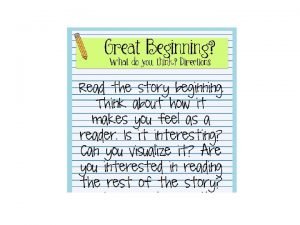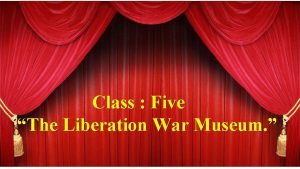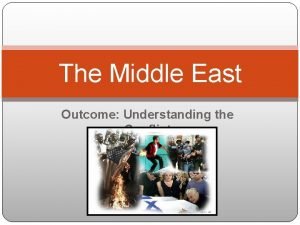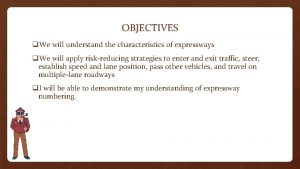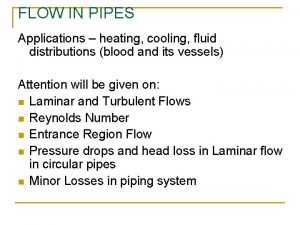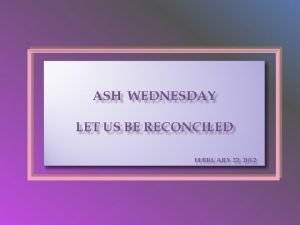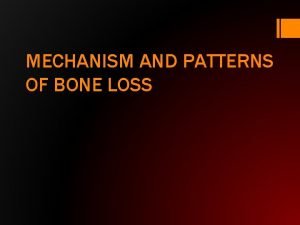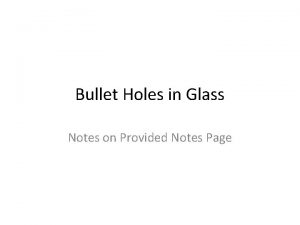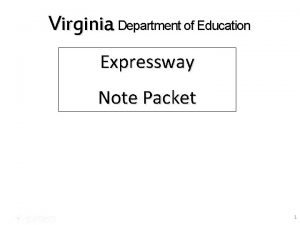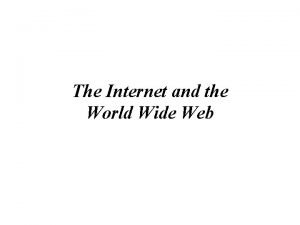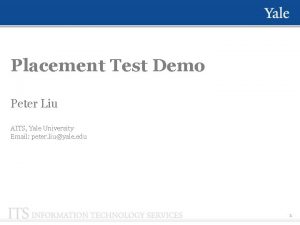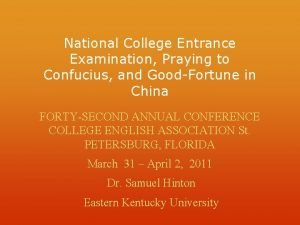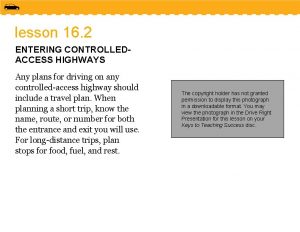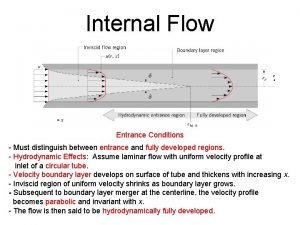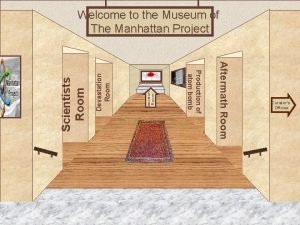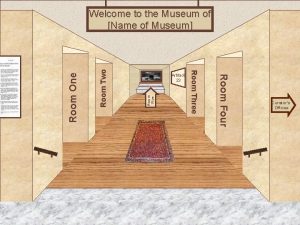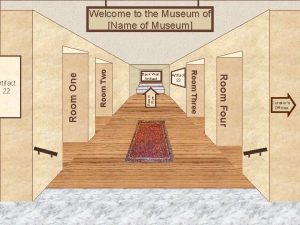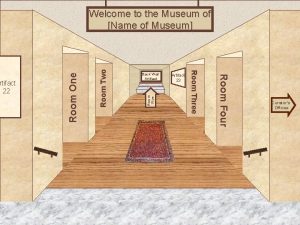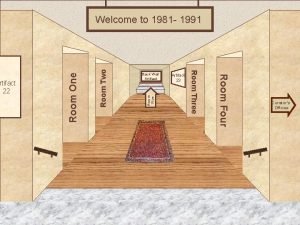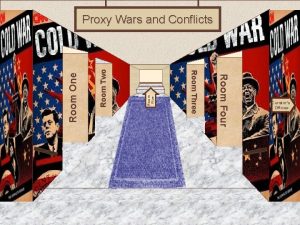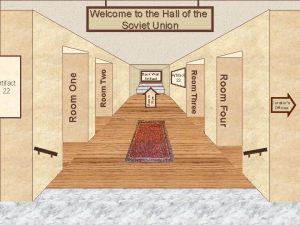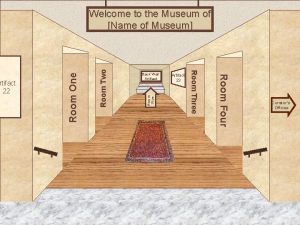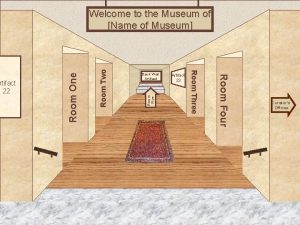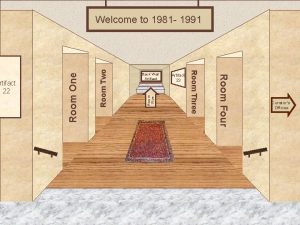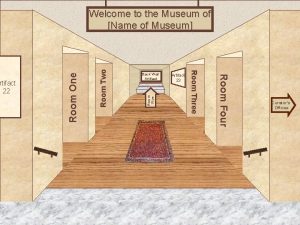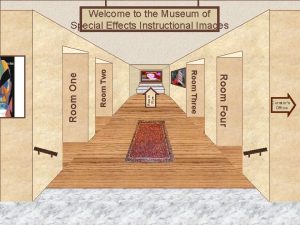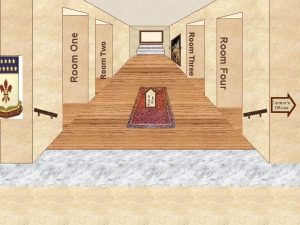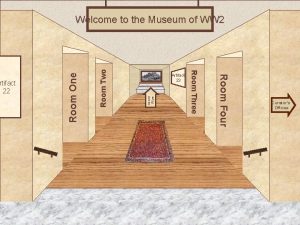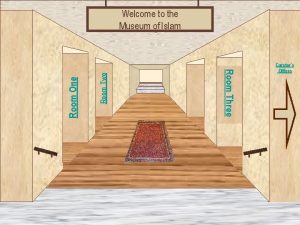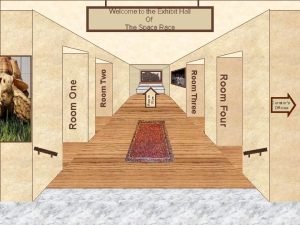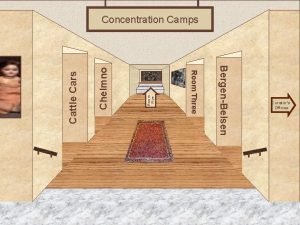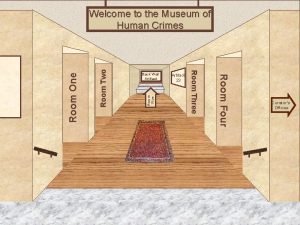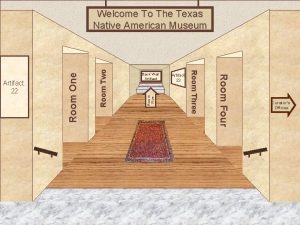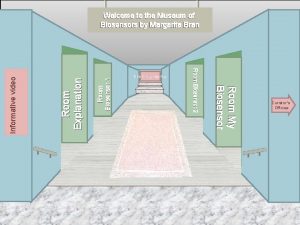Room of Conflicts Museum Entrance War Room Technology






















- Slides: 22

Room of Conflicts Museum Entrance War Room Technology Room Leadership Room Welcome to the Museum of the 60’s Cold War Curator’s Offices

Kacey Haynes Curator’s Office I am currently a sophomore at Clear Springs High School. I am current a student in Mr. Collins Pre-Ap World History class, studying the Cold War. I created this museum to help further my own knowledge about this subject as well as my fellow class mates. Contact me at worldhistory 244@gmail. com Return to Entry Note: Virtual museums were first introduced by educators at Keith Valley Middle School in Horsham, Pennsylvania. This template was designed by Dr. Christy Keeler. View the Educational Virtual Museums website for more information on this instructional technique.

Room of Conflicts Room 5 Return to Entry

Technology Room 2 Return to Entry

War Room 3 ` Return to Entry

Leadership Room 1 Return to Entry

Sino-Soviet Split Cartoon The political split between the Soviet Union and China began after Khrushchev opened talks with the USA in pursuit of his policy of “peaceful coexistence”. In 1960, Khrushchev withdrew Soviet technical advisers from China. This began splits in almost all the Communist Parties across the capitalist world. Then Mao openly criticized Khrushchev for backing down during the Cuban Missile Crisis, and Khrushchev responded that Mao's policies would lead to nuclear war. By June 1963 communications had completely ceased between the two parties. This is significant because it caused a split in the communist party that America wanted to end. Luthi, Lorenz M. , “Mao’s Challenges, 1958, ” in The Sino-Soviet Split: Cold War in the Communist World (Princeton, NJ: Princeton University Press, 2008), 80 -1. Nikita Khrushchev and Mao Zedong with hammer and sickle], 1960. Graphite, ink, and opaque white over graphite underdrawing. Published in the Washington Post, June 24, 1960. Prints and Photographs Division, Library of Congress (24. 00). LC-DIG-ppmsca-19977 Return to Exhibit

Video of the Cuban Missile Crisis With Castro’s approval and great influence, the Soviet Union began building secret missile bases in Cuba. On President Kennedy was shown photographs of the missile installations in Cuba and on October 22, 1962 President Kennedy demanded the removal of the missiles already there and the destruction of the sites and he created a naval blockade of Cuba to stop the construction of the missile sites. Khrushchev sent a letter to Kennedy suggesting that the sites would be dismantled if the United States gave its reassurance that it would not invade Cuba. On October 28, Khrushchev announced that the sites would be dismantled; as well as, the removal of light bombers. Then the United States responded by assurances that the United States not to invade Cuba. This event showed just how high the tensions between the Soviet Union, Cuba and the United States Castro Urges Nuclear Attack on America Video. " History. com. A&E Television Networks, n. d. Web. 22 Apr. 2014 Return to Exhibit Fidel Castro Declares Nuclear Annihilation of U. S.

Pieces of the Wall of Berlin This artifact and the conflict that it caused all began when Germany closes its borders on July 25, 1961. This event occurred just after John F. Kennedy gave a speech a few days before about how an attack on West Berlin would be an attack on NATO. The speech betrayed Khrushchev’s concern with the new Kennedy government and the possibility of a war beginning with confrontation in Berlin and possibly ending in nuclear destruction. August 15, 1961 the Berlin Wall begins as a barbed wire fence but then the next day it is replaced with concrete bricks that go up 2 meters high. The building of the Berlin Wall caused America to stress and closed off connection in West Berlin. This Berlin Wall for Sale - Buy Pieces of the Berlin Wall. . N. p. , n. d. Web. 22 Apr. 2014. Return to Exhibit

TET Offensive Honor Medals "The Tet Offensive 1968. " The Tet Offensive 1968. N. p. , 8 Aug. 2011. Web. 22 Aprr The Tet Offensive Honor Medals are a sign of the 58, 000 American soldiers were killed because of the Viatnam Tet Offensive and just how big of a loss this was to the Americans. The Tet Offensive began when North Vietnam started attacking major towns and cities in South Vietnam in 1968. This was a major turning point of the Vietnam War and America then realized that this war was going to be a struggle. Even though in the end the Americans came out with a victory, this “military conflict” can be considered a loss for the Americans because they did not succeed in stopping the spread of communism which was the whole point of the Cold War. Woods, Alan. “The Tet Offensive: the turning point in the Vietnam War — Part One. ” The Defense of Maxism. 01 January 2008. 21 May 2008. Return to Exhibit

Space Race Timeline The space race was the superpower competition in space exploration technology and also the Cold War competition in arms developments. Coming on the heels of the Soviet Union’s hydrogen bomb tests, Sputnik shocked the American public. USSR continued its lead in space exploration with the first person in space, cosmonaut Yuri Gagarin who orbited earth in Vostok 1, then Allan Shepard became the first American in space. Soon after, President Kennedy he succeeded with the Apollo 11 Mission to the Moon that landed the 1 st person on the moon and. This is significant because it improved the space technology all around the world and also shows the great competition that “Apollo: Expanding Our Knowledge of the Solar System. ” NASA. 03 Dec 2007. National Aeronautics and Space Administration. 2 Jun 2008 Return to Exhibit

1 st Man on the Moon Picture Apollo 11's mission was to land two men on the moon. They also had to come back to Earth safely. Apollo 11 blasted off on July 16, 1969. Neil Armstrong, Edwin "Buzz" Aldrin and Michael Collins were the astronauts on Apollo 11. On July 20, 1969, Armstrong and Aldrin landed on the moon. They landed on the moon in the Eagle. On July 20, 1969, Neil Armstrong became the first human to step on the moon. They put a U. S. flag on the moon. They also left a sign on the moon. On July 24, 1969, all three astronauts came back to Earth safely. President Kennedy's wish came true. The artifact was a picture of the first man on the moon. "Celebration of the First Moon-Walk and The Moon Landing Book List - Jump Into A Book. " Jump Into A Book. Web. 22 Apr. 2014. Return to Exhibit

China’s 1 st Atomic Bomb In July 1960 Chairman Mao Zedong called on Chinese scientists to rely on their own efforts and develop China's atomic bomb within eight years, after the Soviet Union took back the aid the had first given to the development of China’s nuclear technology. Later on October 16, 1964, China successfully exploded its first atomic bomb. On the same day, the Chinese government made a solemn promise to the world that it developed nuclear weapons only for the purpose of "China to Open Bomb Site to Tours. " BBC News. Arin Johnson. 25 June. 2009. Web. 22 Apr. 2014. self-defense and safeguarding national security. China would never at any time or Return to under any circumstances be the first to Exhibit use nuclear weapons. This made them the fifth nuclear power in the world. click here for your own mind blowing experience

Yuri Gagarin Frame and Coin Set Yuri Gagarin was the first human in space as well as the first man to orbit the Earth making a 108 -minute orbital flight in his Vostok 1 spacecraft on April 12, 1961. This artifact is significant because it includes a picture of the USSR cosmonaut and also a one-ruble coin that contains metal from pieces of the former Soviet spacecraft. The flight of Vostok I significant because it ignited what was to become known as the Space Race, between the Soviet Union and the United States. Yuri Gagarin by astronautix. com. Yuri Gagarin Cosmonaut Training Centre: Russia Remembers Space Hero: from BBC. co. uk Return to Exhibit

LIFE Magazine about the Bay of Pigs My artifact is a magazine from 1963 about the effects of the Bay of Pigs on not only the Americans but also the Cuban refugees. In March 1960, President Dwight D. Eisenhower ordered the CIA to train and arm a force of Cuban exiles for an armed attack on Cuba this was later used by John F. Kennedy when he became president. The Bay of Pigs invasion began, on April 17, 1961, when this group of Cuban refugees landed in Cuba at the Bay of Pigs with the hope of destroying the communist government lead by Fidel Castro, but the advance was a failure that cost the US greatly. . This also is significant because this caused Cuba to become closer to the Soviet Union with both of Kennedy, M. David, Lizabeth Cohen and Thomas A. Bailey, Th American Pageant. 13 th ed. Boston: Houghton Mifflin Compan 2006. Print. Return to Exhibit

‘Sudden Sqqual’ by R. G. Smith, NAVY ART This painting is of the Gulf of Tonkin Battle that ultimately began the Vietnam War. On August 2, 1964, North Vietnamese torpedo boats attacked USS Maddox in the first naval engagement of the war. Two days later, the Maddox and another destroyer reported that they were again under attack. Johnson proceeded quickly to authorize retaliatory air strikes against North Vietnam. Two days later on August 7, 1964 , Congress passed the Tonkin Gulf Resolution giving President Johnson authority to take military action in Southeast Asia, this gave congressional approval for expansion of the Vietnam War. This battle that began the war is signifacant because it shows how willing the US was to fight The Reader’s Companion to American History. Eric Foner and John A. Garraty, Editors. Copyright © 1991 by Houghton Mifflin Harcourt Publishing Company. Naval Historical Foundation 1306 Dahlgren Avenue, SE Washington Navy Yard Washington, DC 20374 -5055 Return to Exhibit

Pieces of the U-2 Incident A piece of Gary Powers' aircraft on display to the right. It was given to the museum by the Armed Forces Museum in Moscow where the plane's wreckage is exhibited. On May 1, 1960, while flying a CIA reconnaissance mission in a U-2 reconnaissance aircraft, Gary Powers was shot down over the Soviet Union. Although he parachuted to safety, Powers and his plane wreckage were captured. Soviet Premier Nikita Khrushchev accused the United States of spying. The international turmoil resulted in the cancellation of a summit meeting scheduled between President Eisenhower and the premier. The significance of this incident was that it increased the tension between the two countries at the height of the Cold War. "'U-2 Incident” National Cryptologic Museum. NASA, 20 Jan. 2009. Web. 22 Apr. 2014. Return to Exhibit

Abrams M 1 Battle Tank(named after Creighton Abrams) The artifact seen to the right is an Abrams M 1 battle tank is named after Major General Creighton Abrams, 3 rd Armored Division Commander from 1960 -62. Then on June 1 st, 1967 Abrams was appointed Deputy Commander of U. S. Military Assistance Command, Vietnam and was responsible for overseeing the U. S. advisory effort with the Vietnamese Armed Forces (RVNAF). Thirteen months later, following the Tet Offensive and General Westmoreland’s promotion to Army Chief of Staff, he became Commander of MACV. Abrams continued to rise in the ranks and was best known for skillfully presiding over America’s withdrawl from Vietnam. "Lyndon B. Johnson. " History. com. A&E Television Networks, Web. 22 Apr. 2014. Return to Exhibit

Lyndon Johnson’s Slogan Button This artifact is important because it represent the man that could be blamed for much of the losses that occurred during the Vietnam War. After taking over as chief executive following the assassination of President John Kennedy, Lyndon Johnson promised to continue his predecessor’s policies in international affairs which was a very hard task that he couldn't in the end achieve. Johnson’s foreign policy, of anti-communism, remains best known for his handling of the Vietnam War and had a great affect on the stress of The Cold War. Throughout his presidency, he did the minimum possible to ensure that South Vietnam did not become a Communist state. Unfortunately for the President, the “minimum possible” grew to dangerous extremes-U. S. troop totals, from 16, 000 to 532, 000 during Johnson's Presidency. Johnson’s policies brought the United States no closer to victory in Vietnam, Kunz, Diane, ed. , The Diplomacy of the Crucial Decade: American Foreign Relations during the 1960 s (New York: Columbia University Press, 1994). " Return to Exhibit

Fidel Castro’s Potriat This artifact is a potriat of the Cuban leader Fidel Castro, who established the first communist state in the Western Hemisphere after leading an overthrow of the military dictatorship of Fulgencio Batista in 1959 during 1962. He ruled over Cuba for nearly five decades during that time, Castro’s regime was successful in reducing illiteracy, stamping out racism and improving public health care, but he stifled all economic and political freedoms. Castro’s Cuba also had a highly antagonistic relationship with the United States–most notably resulting in the Bay of Pigs invasion and the Cuban Missile Crisis during the Cold War. "Fidel Castro. " History. com. A&E Television Networks, Web. 22 Apr. 201 Return to Exhibit

Lincoln Continental Limousine. On the 22 of November 1963 John F Kennedy was assassinated at the Dallas' Dealey Plaza while riding the artifact seen to the right. This car is a four door Lincoln Continental limousine. Before Kennedys death he did many important things. On November 8, 1960 John F Kennedy beat out Nixon and was elected to be the President of the United States. During his presidency Kennedy gave many inspirational speeches to get his the American people to be more active in his country. An example of this is when he said, "Ask not what your country can do for you--ask what you can do for your country“. He is well known for the following things, including the negotiation of the Cuban Missile Crisis, the Bay of Pigs and also the initiation of the Alliance for Progress Press, Julie Hinds Detroit Free. "JFK's Limo an Enduring Symbol of Dark Day. " USA Today. Gannett, 20 Nov. 2013. Web. 23 Apr. 2014. Return to Exhibit

Return to Exhibit
 Let's look at some examples
Let's look at some examples A visit to the liberation war museum
A visit to the liberation war museum Norwegian museum of science and technology
Norwegian museum of science and technology Curriculum guide for driver education in virginia module 5
Curriculum guide for driver education in virginia module 5 Entrance hidden by bricks and rubble
Entrance hidden by bricks and rubble Darkroom illumination
Darkroom illumination Entrance là loại hoạt cảnh
Entrance là loại hoạt cảnh Three parts of an expressway entrance
Three parts of an expressway entrance Inward projecting pipe entrance
Inward projecting pipe entrance Entrance culvert
Entrance culvert Construction entrance
Construction entrance Entrance antiphon for today's mass
Entrance antiphon for today's mass Bulbous bone contours
Bulbous bone contours 22 bullet hole in glass
22 bullet hole in glass 2 wire video door entry system
2 wire video door entry system York hospital eye clinic
York hospital eye clinic Bayview secondary school ib entrance exam
Bayview secondary school ib entrance exam Acceleration lane
Acceleration lane An organization providing an entrance ramp to internet
An organization providing an entrance ramp to internet Liu math entrance exam samples
Liu math entrance exam samples Prayer before taking entrance exam
Prayer before taking entrance exam Short entrance lane
Short entrance lane Entrance length
Entrance length
